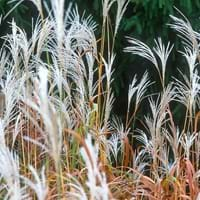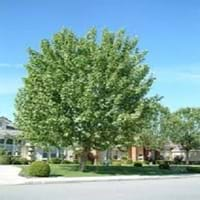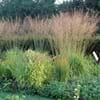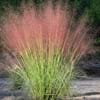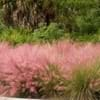Life Span
Perennial
Perennial
Origin
Africa, Southern Asia
California
Types
Not Available
American Sycamore, Arizona Sycamore
Number of Varieties
Not Available
Habitat
Floodplains, meadows, Riverbanks
Floodplains, River side, Stream side
USDA Hardiness Zone
4-9
3-8
Sunset Zone
Not Available
4, 5, 6, 7, 8, 9, 10, 11, 12, 13, 14, 15, 16, 18, 20, 21, 22, 23, 24
Habit
Clump-Forming
Upright/Erect
Flower Color
Not Available
Yellow
Flower Color Modifier
Bicolor
Bicolor
Fruit Color
Not Available
Sandy Brown
Leaf Color in Spring
Dark Green
Light Green
Leaf Color in Summer
Light Green
Light Green
Leaf Color in Fall
Orange, Light Yellow, Gold, Brown, Bronze
Sandy Brown
Leaf Color in Winter
Orange, Light Yellow, Gold, Brown, Bronze
Not Available
Leaf Shape
Long Linear
Toothed
Plant Season
Summer, Fall
Not Available
Sunlight
Full Sun, Partial Sun
Full Sun, Partial Sun
Type of Soil
Loam
Clay, Loam, Sand
The pH of Soil
Acidic, Neutral
Acidic, Neutral
Soil Drainage
Average
Average
Bloom Time
Late Spring, Early Summer, Summer, Late Summer, Early Fall
Not Available
Tolerances
Drought
Wet Site, Drought
Where to Plant?
Container, Ground, Pot
Ground
How to Plant?
Divison, Seedlings
Seedlings, Stem Planting, Transplanting
Plant Maintenance
Medium
Medium
Watering Requirements
Requires regular watering
Keep the ground moist but not water-logged, Never Over-water
In Summer
Lots of watering
Lots of watering
In Spring
Moderate
Moderate
In Winter
Average Water
Average Water
Soil pH
Acidic, Neutral
Acidic, Neutral
Soil Type
Loam
Clay, Loam, Sand
Soil Drainage Capacity
Average
Average
Sun Exposure
Full Sun, Partial Sun
Full Sun, Partial Sun
Pruning
Remove dead or diseased plant parts
Prune in the late winter or spring, Remove damaged leaves, Remove dead leaves, Remove hanging branches, Remove short branches, Remove short twigs
Fertilizers
All-Purpose Liquid Fertilizer
All-Purpose Liquid Fertilizer
Pests and Diseases
Not Available
Red blotch
Plant Tolerance
Drought
Drought
Flowers
Not Available
Insignificant
Flower Petal Number
Single
Not Available
Foliage Texture
Medium
Coarse
Foliage Sheen
Matte
Matte
Attracts
Not Available
Not Available
Allergy
Asthma
Asthma, Eye irritation, Skin irritation
Aesthetic Uses
Showy Purposes
Beautification, Landscape Designing, Showy Purposes
Beauty Benefits
Not Available
Not Available
Environmental Uses
Air purification
Air purification
Medicinal Uses
No Medicinal Use
Cold, Cough, Dysentry, Pain killer
Part of Plant Used
Whole plant
Fruits
Other Uses
Used as Ornamental plant
Decoration Purposes, Showy Purposes, Used as Ornamental plant
Used As Indoor Plant
Insignificant
No
Used As Outdoor Plant
Yes
Yes
Garden Design
Container, Hedges, Mixed Border, Screening / Wind Break
Shade Trees
Botanical Name
MISCANTHUS sacchariflorus
PLATANUS racemosa
Common Name
Amur Silvergrass
California Sycamore
In Hindi
Amur Silvergrass
कैलिफोर्निया गूलर
In German
Amur Schilf
California sycamore
In French
Amur silvergrass
californie sycomore
In Spanish
Amur silvergrass
california sicómoro
In Greek
Amur Silvergrass
Καλιφόρνια συκομουριά
In Portuguese
Amur Silvergrass
califórnia sicômoro
In Polish
Amur Silvergrass
california jawor
In Latin
Amur Silvergrass
california sycomoros
Phylum
Magnoliophyta
Magnoliophyta
Class
Liliopsida
Magnoliopsida
Order
Cyperales
Proteales
Family
Poaceae
Platanaceae
Genus
Miscanthus
Platanus
Clade
Angiosperms, Commelinids, Monocots
Angiosperms, Eudicots
Tribe
Not Available
Not Available
Subfamily
Panicoideae
Not Available
Number of Species
Not Available
Properties of Amur Silvergrass and California Sycamore
Wondering what are the properties of Amur Silvergrass and California Sycamore? We provide you with everything About Amur Silvergrass and California Sycamore. Amur Silvergrass doesn't have thorns and California Sycamore doesn't have thorns. Also Amur Silvergrass does not have fragrant flowers. Amur Silvergrass has allergic reactions like Asthma and California Sycamore has allergic reactions like Asthma. Compare all the properties and characteristics of these two plants. Find out which of these plant can be used as indoor plant. If you are interested to decorate your house and garden, find out aesthetic uses, compare them and select the plant which will beautify your surrounding. Along with beautification, try comparing medicinal and edible uses of Amur Silvergrass and California Sycamore and you can choose the plant having best and most benefits.
Season and Care of Amur Silvergrass and California Sycamore
Season and care of Amur Silvergrass and California Sycamore is important to know. While considering everything about Amur Silvergrass and California Sycamore Care, growing season is an essential factor. Amur Silvergrass season is Summer and Fall and California Sycamore season is Summer and Fall. The type of soil for Amur Silvergrass is Loam and for California Sycamore is Clay, Loam, Sand while the PH of soil for Amur Silvergrass is Acidic, Neutral and for California Sycamore is Acidic, Neutral.
Amur Silvergrass and California Sycamore Physical Information
Amur Silvergrass and California Sycamore physical information is very important for comparison. Amur Silvergrass height is 90.00 cm and width 90.00 cm whereas California Sycamore height is 1,830.00 cm and width 1,520.00 cm. The color specification of Amur Silvergrass and California Sycamore are as follows:
Amur Silvergrass flower color: Not Available
Amur Silvergrass leaf color: Dark Green
California Sycamore flower color: Yellow
- California Sycamore leaf color: Light Green
Care of Amur Silvergrass and California Sycamore
Care of Amur Silvergrass and California Sycamore include pruning, fertilizers, watering etc. Amur Silvergrass pruning is done Remove dead or diseased plant parts and California Sycamore pruning is done Prune in the late winter or spring, Remove damaged leaves, Remove dead leaves, Remove hanging branches, Remove short branches and Remove short twigs. In summer Amur Silvergrass needs Lots of watering and in winter, it needs Average Water. Whereas, in summer California Sycamore needs Lots of watering and in winter, it needs Average Water.
